Transylvania Is Known for Its Mythic Tales — Now 2 Chic New Hotels are Offering Another Reason to Visit
This storied region in Romania is a land of vast wilderness, regal countesses, and plenty of folklore.
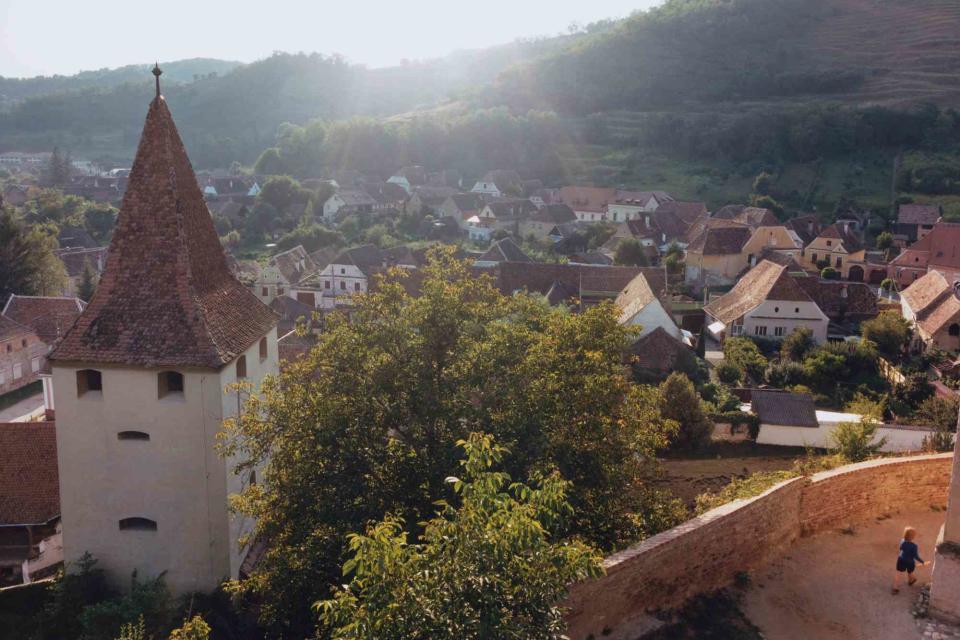
Kate Eshelby
Transylvania is known for its fortified churches, like this one in the village of Biertan.In the early afternoon, my family and I strode out of a beech forest and onto a sweep of high grassland, where an expanse of oak trees stood like solitary guards. A picnic was waiting for us, with goulash cooking over a fire and a table laid with a bright, cherry-colored cloth.
This was the Breite, one of Europe’s best-preserved wood pastures, a type of forest that is managed through grazing. It was here, deep in Transylvania, that the Saxons — Germanic people who arrived in Romania in the 12th century — used to come to fatten their pigs on the plentiful acorns. Some of the Breite’s oldest trees, with deep grooves in their bark, have towered since the Middle Ages. “These furrows are home to the great capricorn beetle,” Peter Suciu, our guide, told us. The insects are rare in other parts of Europe that have lost their old trees, the beetles’ preferred habitat.
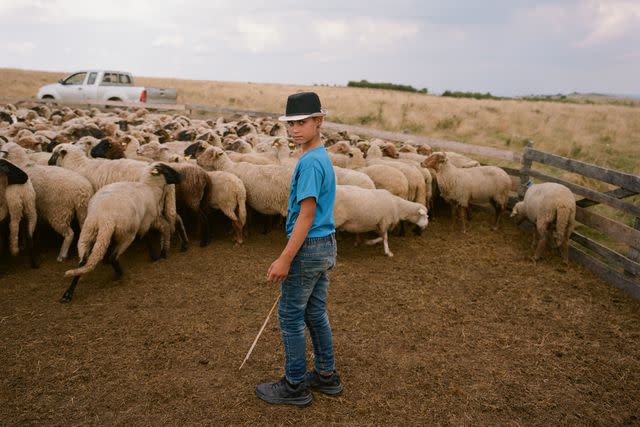
Kate Eshelby
A young shepherd tends to his flock in the hills near the village of Viscri.Transylvania, Romania’s largest and most famous region, is a place where blacksmiths still mold metal, shepherds live alone with their flocks, and hay is cut with scythes. It’s a land of villages with terra-cotta-tiled homes and vast wildernesses where bears, wolves, and lynx patrol primeval forests.
In the clearing, Suciu showed us how to cook slănină, cured slabs of pork fat, on sticks over the flames. “This is one of our most popular foods,” he said as we dripped its delicious, hot, golden juice onto hunks of freshly baked bread. We had met Suciu earlier that day, when he collected us from Bethlen Estates Transylvania, in the medieval village of Criș, where I was staying with my husband and two young sons. Only in the past several years have accommodations opened in these places, offering travelers the chance to experience a way of life that feels bygone.
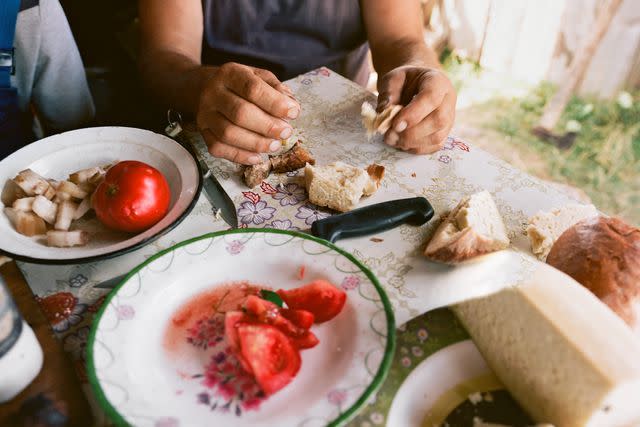
Kate Eshelby
A snack of bread and tomatoes with a local sheepherding family.For centuries, Romania was a place of turbulence. Having been claimed by a number of history’s great empires — the Romans, the Ottomans, and the Austro-Hungarians — it was consistently under attack. More recently (from 1948 to 1989), the country operated as a satellite state of the Soviet Union.
For nearly two decades, Count Miklós Bethlen, who had grown up in the family’s castle in Criș, lived in exile. He returned in 1967 and, until his death in 2001, was devoted to restoring the village and its properties, which had fallen into disrepair during the Communist era. This restoration has been continued by his widow, Countess Gladys Bethlen, and her son, Miklós, who now run a collection of accommodations occupying historic buildings on their sweeping family lands. Bethlen Estates first opened to guests in 2018 with the Caretaker’s House, which has four bedrooms, a full kitchen, a sauna, a pool, and a library. A two-bedroom Saxon-style cottage, Depner House, opened in 2021, as did the four-bedroom Corner Barn (originally used for storing hay). The Bethlens are also renovating the village’s old Saxon schoolhouse.
We’d arrived at the Caretaker’s House after crossing a wooden bridge over a stream and then following a winding path. Dormer windows protruded from the pitched roof like sleepy crocodile eyes. Inside, the bedrooms had sumptuous linens and traditional tiled stoves.
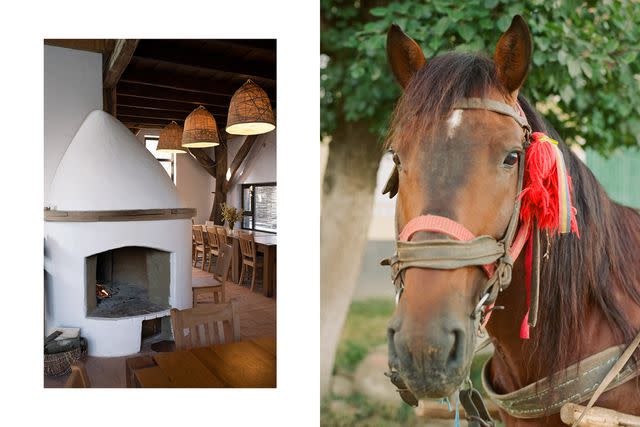
Kate Eshelby
From left: The dining room at Viscri 125, a guesthouse in Viscri; in Transylvanian folklore, red tassels are believed to protect against the evil eye.Days at Bethlen are simple but sublime. One afternoon we whizzed across meadows on e-bikes; it was April, and we could see the snow-streaked peaks of Romania’s highest mountains, the Făgăraș Range, on the horizon. Another day we walked to the village of Malancrav, before realizing we might be late for dinner. After lively negotiations with a local family, we rode back through the forest on their horse-drawn cart (rattling down hills so fast that I was a little terrified, but my children were delighted). The red wool tassels on the horse’s harness — believed to protect against the evil eye — caught the air as we went.
Thanks to our shortcut, we made it in time to sit down in the communal dining barn. First, tomato soup with sour cream and caviar, then Hungarian Mangalica pork with spring vegetables, followed by chocolate torte with peach marmalade. The Countess told us of her late husband’s love of the area. “His roots remained so deeply entrenched in this land that our children had to beg him to stop telling stories of his childhood,” she said with a gutsy laugh. Later, as my family and I strolled back up the hill to bed, I could imagine the estate’s former grandeur as I looked at the ruins of the granary and, in the distance, the Renaissance-era Bethlen Castle, where the family had lived at the height of its aristocratic power.
After several days at Bethlen, we drove an hour east to Viscri, one of Transylvania’s best-preserved Saxon villages, with pastel-colored houses leading up to its unesco-listed fortified church. One of them belongs to Britain’s King Charles III, although it’s easy to pass by without knowing — his heraldic badge is discreetly stuccoed into the home’s blue walls.
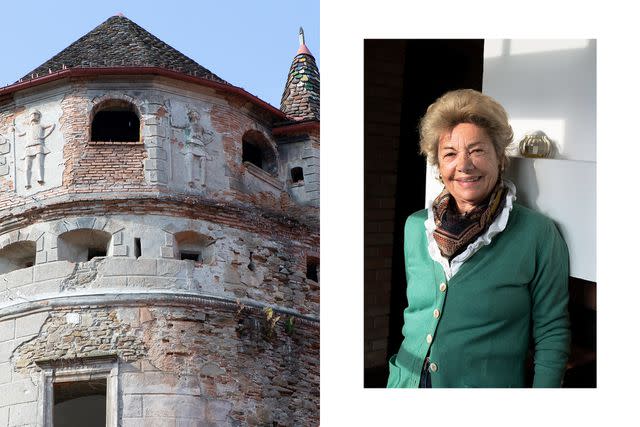
Kate Eshelby
From left: Bethlen Castle, in the village of Criș; Countess Gladys Bethlen.Our home for the next few days was another old residence and farm, Viscri 125, which has been restored into a stylish, simple guesthouse with 11 rooms. The owners, Mihai and Raluca Grigore, live next door with their three children. “We moved here from Bucharest in 2007 because we loved the architecture of the village, being in nature, and the community,” Raluca told me.
One evening we ate at the home of Gerda Gherghiceanu, the Grigores’ neighbor, who hosts meals for hotel guests. After dinner she showed us her cellar, where she stores jars of homemade jams, stewed fruits, and pickled vegetables, all made with produce from her own orchards and gardens.
Leaving Gherghiceanu’s house just before twilight, we watched as hundreds of farm animals streamed up the road with an orchestra of hooves and bells. In spring, when the grass flushes green, the herds return home from grazing in the hills each nightfall by themselves. First the goats, then the cows, then the water buffalo with their long black snouts. It was a sight that felt timeless, as the sun turned everything gold.
How to Get to Translyvania
Most visitors will begin their trip in Bucharest, the Romanian capital. From there it is a four-hour drive northwest to the border of Transylvania. The best way to visit the region is with the help of a tour operator: I went with Romania Private Tours, which can create customized itineraries incorporating stays at Bethlen Estates Transylvania, in the village of Criș, and Viscri 125, in the village of Viscri, plus excursions like horseback riding, hiking, foraging, cooking classes, and dinner with a local family.
A version of this story first appeared in the June 2023 issue of Travel + Leisure under the headline "The Land Before Time."
For more Travel & Leisure news, make sure to sign up for our newsletter!
Read the original article on Travel & Leisure.

